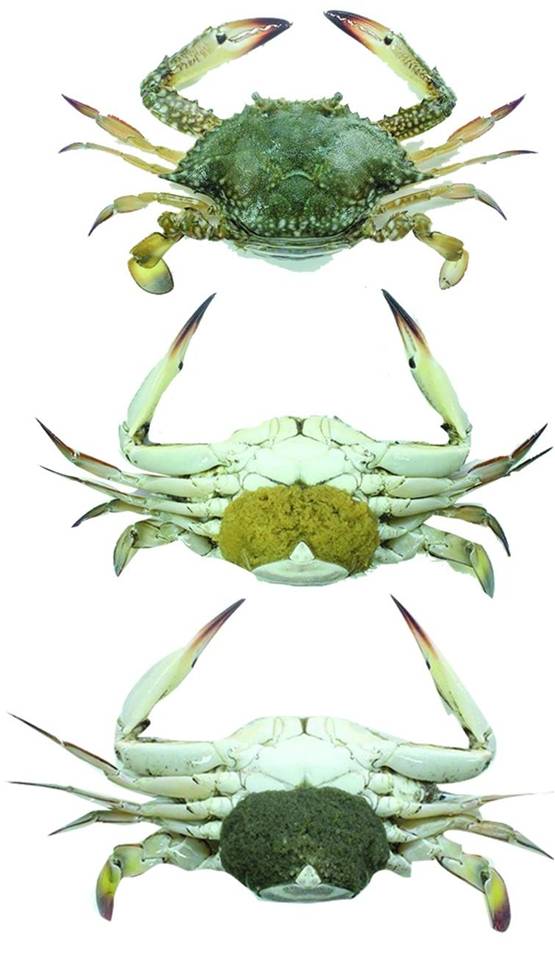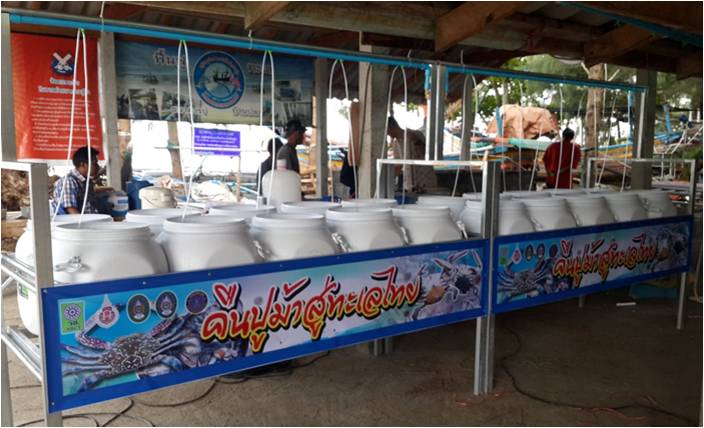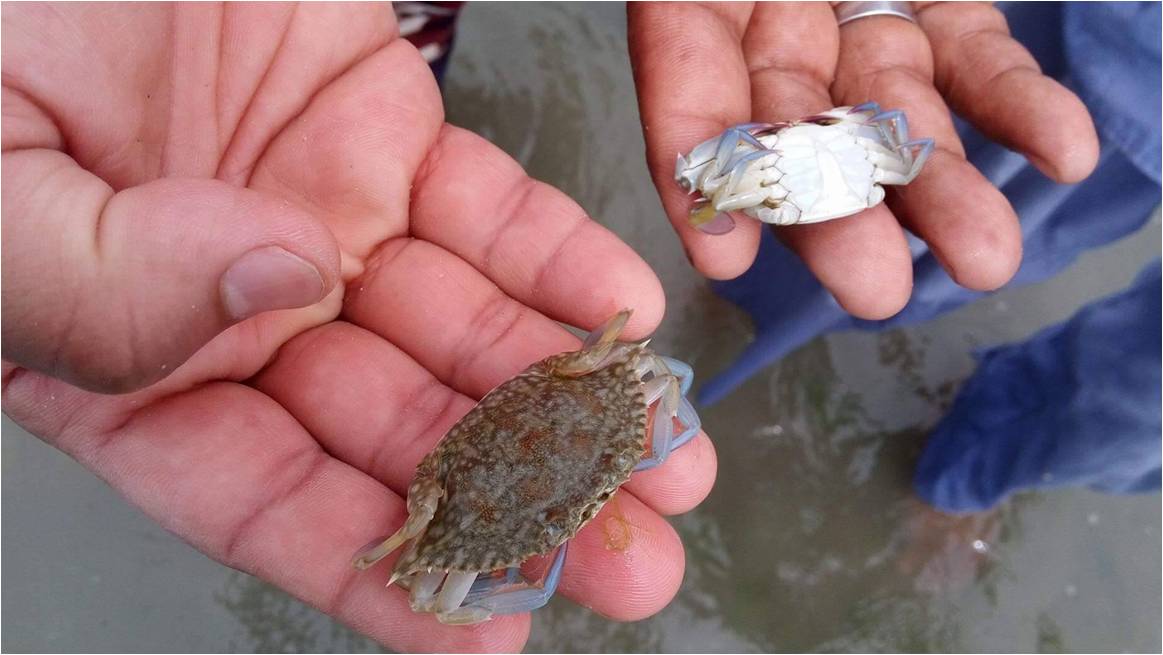Science & Technology
Crab Bank – Application for marine fishery restoration
Walailak Innovation 15, April 2019
Crab Bank – Application for marine fishery restoration
ธนาคารปูม้า นับเป็นเครื่องมือที่สำคัญเพื่อการฟื้นฟูทรัพยากรประมงและระบบนิเวศที่เกี่ยวข้อง การบริหารจัดการธนาคารปูม้าเป็นการบูรณาการองค์ความรู้จากสหสาขาวิชาการรวมทั้งการบูรณาการความร่วมมือของหลากหลายภาคส่วนเพื่อเพิ่มโอกาสความสำเร็จและความยั่งยืนของทรัพยากรและระบบนิเวศ ธนาคารปูม้า นับเป็นประเด็นร้อนทางการจัดการทรัพยากรประมงในปัจจุบัน เนื่องจากปริมาณปูม้า (Portunus pelagicus Linnaeus, 1758) ในธรรมชาติมีจำนวนลดลงอย่างมาก ขณะที่ปูม้าเป็นสัตว์น้ำที่นิยมบริโภคในประเทศ รวมทั้งเป็นสัตว์ทะเลที่มีความสำคัญทางเศรษฐกิจโดยประเทศไทยจัดเป็นผู้ส่งออกรายใหญ่อันดับ 4 ของโลก ดังนั้นการบริหารจัดการทรัพยากรปูม้าเพื่อความยั่งยืนจึงเป็นประเด็นที่ได้รับความสนใจอย่างมากในปัจจุบัน ประกอบกับข้อมูลทางวิชาการชี้ให้เห็นว่าปูม้าสามารถสืบพันธุ์ได้ทั้งปี และปูม้ามีความดกไข่สูง โดยเฉลี่ยประมาณ 1 ล้านฟองต่อตัว ดังนั้นการนำไข่นอกกระดอกมาเพาะฟักแล้วปล่อยคืนสู่ทะเลจะเป็นแนวทางเพิ่มอัตราการทดแทนปูม้าในธรรมชาติ
และนำมาสู่การใช้ประโยชน์ได้อย่างยั่งยืน
Crab bank is an important strategy for the restoration of fishery resources and related ecosystems. The management of the blue crab bank is the integration of knowledge from multidisciplinary as well as integrating the cooperation of various sectors in order to increase the opportunity, success and sustainability of resources and ecosystems. The blue crab bank is considered a hot issue in the current fishery resource management because the amount of blue crabs (Portunus pelagicus Linnaeus, 1758) in nature has decreased dramatically. The blue crab is a popular seafood consumed in the country as well as being an important marine economy, with Thailand being the fourth largest exporter in the world. Therefore, the management of blue crab resources for sustainability is an issue that has received much attention today. Together with academic data indicating that the blue crab can reproduce all year and has a high egg abundant on average about 1 million eggs each. Therefore, bringing the eggs outside to be hatched and released to the sea will be a way to increase the rate of replacement of blue crabs in nature leading to sustainable consumption in the future.

การบริหารจัดการธนาคารปูม้า นอกจากมีความเข้าใจในโครงสร้างธนาคารปูม้า ยังต้องมีความเข้าใจและสามารถจัดการองค์ความรู้ที่หลากหลายที่เกี่ยวข้อง เช่น สภาพแวดล้อมและระบบนิเวศที่เอื้อต่อการอยู่อาศัยของปูม้า เช่น ความเค็มมากว่า 27-35 อุณหภูมิ 26-32 องศาเซลเซียส เป็นต้น มีความเข้าใจในแหล่งอนุบาลสัตว์น้ำหากมีแหล่งหญ้าทะเลและพื้นที่สันดอนทรายเป็นแหล่งหลบภัยของตัวอ่อนจะทำให้เพิ่มอัตราการรอดมากขึ้น รวมทั้งความเข้าใจเทคนิคการปล่อยปูม้าจะสามารถเพื่อเพิ่มอัตราการรอด เทคโนโลยีสารสนเทศทางภูมิศาสตร์ และแบบจำลองกระแสน้ำ จะช่วยทำให้ทราบถึงพื้นที่ปล่อยลูกปูม้าที่เหมาะสม รวมทั้งความเข้าใจบริบทสังคมชุมชนและการมีส่วนร่วมของชุมชนจะนำมาสู่การพัฒนาที่ยั่งยืน
Management of blue crab banks requires not only the understanding of blue crab bank structure but also understanding and being able to manage a variety of relevant knowledge, such as the environment and ecosystems that are conducive to the habitat of blue crabs such as salinity more than 27-35, temperature 26-32 degrees Celsius. If there are seagrass sources and sand shoals which are an embryo shelter, it will increase the survival rate of blue crabs. Furthermore, the understanding of the technique of releasing blue crabs will also help increasing their survival rate. Geographic Information Technology and the current model will help indicating the appropriate areas of the baby crab release integrated with understanding of the social context, community and community participation leading to sustainable development.

ข้อมูลวิชาการจากการวิจัยเพื่อฟื้นฟูทรัพยากรปูม้า นำไปใช้ประโยชน์เพื่อประเมินยกระดับการทำการประมงของไทย (Fishery improvement program) สามารถขยับระดับมาตรฐานของการประมงไทย จากระดับ C เป็นระดับ A และได้แสดงผลการประเมินในฐานข้อมูลที่ได้รับความเชื่อถือจากสากลประเทศ ผ่านเว็ปไซต์การประมงนานาชาติ (www.fisheryprogress.org) รวมทั้งได้ประยุกต์ใช้องค์ความรู้จัดทำธนาคารปูม้าจำนวน 60 แห่ง ตลอดแนวชายฝั่งตั้งแต่อำเภอท่าชนะ จังหวัดสุราษฏร์ธานี ลงมาถึงอำเภอหัวไทร จังหวัดนครศรีธรรมราช ในหลายพื้นที่ซึ่งมีการบริหารจัดการระบบนิเวศที่เกี่ยวข้องควบคู่กับการจัดทำธนาคารปูม้า พบว่าสามารถพบตัวอ่อนปูม้าจำนวนมาก และจากการสัมภาษณ์ชาวประมงจับปูม้าได้มากขึ้น และมีรายได้จากการประมงเพิ่มขึ้น
Academic information from research to restore blue crab resources will be used for the evaluation of Thai fishery improvement (Fishery improvement program) which will be able to move the Thai fishery standard level from level C to level A with displayed results in the database trusted by international countries through the international fishing website (www.fisheryprogress.org). From fisherman interviews, application of knowledge to create 60 blue crab banks along the coast from Tha Chana district Surat Thani Province descending to Hua Sai District Nakhon Si Thammarat with ecological management and the preparation of blue crab banks resulted in the increase of crab larvar as well as the fishery of blue crab harvest leading to the increase of income of local fisherman.

Inventor:
-
School of Science,Walailak University, Thasala, Nakhon Si Thammarat 80160
Research Fundings
-
Full research scholarships supported by Agricultural research development Agency, Ministry of science and technology and National research council of Thailand
Awards:
-
รางวัลรบริการภาครัฐ (good governance for better life) มอบโดย สำนักงาน กพร. ปี พ.ศ. 2561
-
รางวัลชนะเลิศผลงานสร้างสรรค์เพื่อการขยายผลธนาคารปูม้า งานนักประดิษฐ์ มอบโดย สำนักงานคณะกรรมการวิจัยแห่งชาติ ปี พ.ศ. 2562
WebPage:
Facebook: wufrontovation
Related Link:
- College of Graduate Studies, Walailak University
- Facebook of College of Graduate Studies